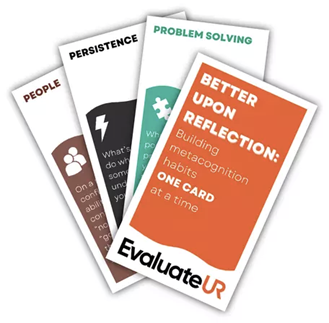by Dr. Lauren Scharff, U. S. Air Force Academy
We all know that it’s difficult to break long-term patterns of behavior, even when we’re genuinely motivated and well intentioned. It becomes significantly more difficult when we are trying to shift behavioral patterns of groups. This is true across a spectrum of situations and behaviors, but in this post I will focus on teachers and students shifting from a focus on content and basic skills to a focus on higher-level thinking and metacognitive skills.
These musing on “breaking the content mold” have become much more salient as I look forward to a new semester and I exchange ideas with colleagues about how we will approach our upcoming classes. I refer to the “content mold” as a way of illustrating how we, both students and teachers, have been shaped, or molded, by many years of prior experiences and expectations. Due to this shaping, the natural default for both groups is to teach or learn in ways that we have been exposed to in the past, especially if those approaches have seemed successful in the past. For many of us, this default is a focus on content and on disciplinary skills closely linked with the content. With conscious effort we can break out of that molded pattern of behavior to encourage interdisciplinary thinking and higher-level thinking skills that transfer beyond our course. However, when things get tough (e.g. when there are time constraints, high cognitive load situations, or pressures to achieve success as portrayed by exam scores), we tend to revert back to the more familiar patterns of behaviors, which for many of us means a focus on content and basic skills, rather than the use of higher-level thinking or metacognitive strategies.
Similarly, in an earlier post on this site, Ed Nuhfer points out that, “When students learn in most courses, they engage in a three-component effort toward achieving an education: (1) gaining content knowledge, (2) developing skills (which are usually specific to a discipline), and (3) gaining deeper understanding of the kinds of thinking or reasoning required for mastery of the challenges at hand. The American higher educational system generally does best at helping students achieve the first two. Many students have yet to even realize how these components differ, and few ever receive any instruction on mastering Component 3.”
One of the biggest challenges to breaking this molded pattern is that it will be far more likely to be successful if both the teacher and the student are genuinely engaged in the effort. No matter how much effort is put forth by an instructor, if value is not perceived by the student, then little change will occur. Similarly, even if a student has learned the value of higher-level thinking and metacognitive approaches, if a teacher doesn’t seem to value those efforts, then a student will astutely focus on what does seem to be valued by the teacher. A further challenge is that, over the course of a semester, the effort and motivation from both groups might wax and wane in a non-synchronous manner. As I explore these challenges, I will use myself and my less-than-successful efforts last semester as an example.
I taught an upper-level majors course in vision science, and because I have taught this course many times, I knew going in that the material is often unexpectedly challenging to students and most of them find the chapter readings to be difficult. (They contain a lot of brain biology and neural communication topics, and my students are not biology majors). Thus, I decided to build in a low-threat (with a small number of points), intentional, metacognitive reflection assignment for each lesson that had a reading. Students would indicate their level of reading completion (six levels encompassing a thorough reading with annotations, skimming, not at all) and their level of understanding of the material before class. If they had problems with any of the materials, they were supposed to indicate what steps they would take to develop understanding. They would record these and turn them in at mid-semester and at the end of the semester. I had hoped that this regular reflection would prompt their awareness of their reading behaviors and their level of learning from the reading, initiate proactive behaviors if they had poor understanding, and build habits by being completed regularly. I also took time at the start of the semester to explicitly explain why I was incorporating this regular reflection assignment.
Unfortunately, except for a couple of students, I would rate this assignment as a failure. I don’t believe it did any harm, but I also don’t believe that students used it as intended. Rather, I think most of them quickly and superficially answered the questions just so they could turn in their logs at the two required times. This type of reflection is not something that they have been asked to explicitly do in the majority (all?) of their prior courses, and they already had other strategies that seemed to work for their success in other classes For example, more than half way through the semester one student informed me that it was simply easier and faster to come to the teacher’s office and get reading guide answers (or homework problem solutions in other courses), rather than deeply read and try to figure it out on his own. Thus, if he didn’t understand as he skimmed, he didn’t worry about it. This approach wasn’t working well in my course, but up to that point he’d been very successful, so he persisted in using it (although I stopped answering his questions in my office until he could demonstrate that he’d at least tried to figure them out).
In hindsight, I believe that my actions (or lack of them) also fed into the failure. I assumed that students would bring their questions to class if they had them due to their increased awareness of them and the prompt about what they would do to increase their understanding. Thus, if there were no questions (typically the case), I used the class time to connect the readings with related application examples and demonstrations rather than reiterated what was in the readings. The students seemed engaged in class and showed no indication of specific problems with the readings. Their personal application reflection writing assignments (separate from the reading logs) were fantastic. However, their poor exam performance suggested that they weren’t deeply understanding the content, and I instinctively shifted back to my prior content-focused approaches. I also did not take time in class to directly ask them about their understanding of the readings, what parts they found most challenging, and why.
Thus, although I know I wanted to support the development of student metacognitive skills, and my students also seemed accepting of that goal when I introduced it to them at the beginning of the semester, both groups of us quickly reverted to old content-focused habits that had been “successful” in the past. I am not the first to note the challenges of developing metacognitive skills. For example, Case and Gunstone (2002) state the following, “Many … authors have emphasized that metacognitive development is not easy to foster (e.g., Gunstone & Mitchell, 1998; White, 1998). Projects to enhance metacognition need to be long-term, and require a considerable energy input from both teachers and students.”
So, what will I do in the future? My plans are to more regularly and explicitly engage in discussion of the reading reflection prompts (and other metacognitive prompts) during class. By giving class time to such discussion and bringing the metacognitive processes into the open (rather than keeping them private due to completion outside of class), I hope to indicate the value of the processes and more directly support student exploration of new ways of thinking about learning. Importantly, I hope that this more public sharing will also keep me from falling back to a simple content focus when student performance isn’t what I’d like it to be. Ultimately, metacognitive development should enhance student learning, although it is likely to take longer to play out into changed learning behaviors. I need to avoid the “quick fix” of focusing on content. Thus, I plan to shape a new mold for myself and openly display it my students. We’ll all be more likely to succeed if we are “all in” together.
——–
Nuhfer, E. (15 July 2014). Metacognition for Guiding Students to Awareness of Higher-level Thinking (Part 1). Improve with Metacognition. https://www.improvewithmetacognition.com/metacognition-for-guiding-students-to-awareness-of-higher-level-thinking-part-1/
Case, J. & Gunstone, R. (2002). Metacognitive Development as a Shift in Approach to Learning: An in-depth study. Studies in Higher Education 27(4), p. 459-470. DOI: 10.1080/0307507022000011561



